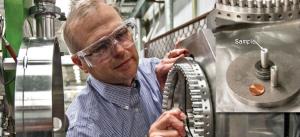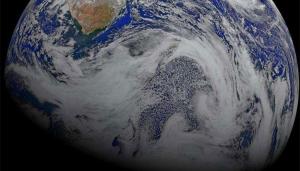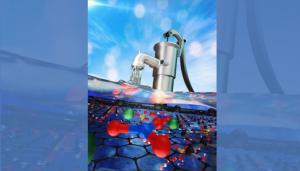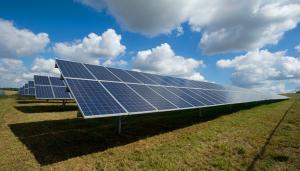LAB REPORT
Science and Technology Making Headlines
Sept. 27, 2019


LLNL physicist Bruce Buchholz uses the bomb pulse of carbon 14 to date human cells and tissues.
Tracking the bomb pulse
Everything alive today contains carbon 14. Naturally occurring carbon 14 comes from cosmic rays. But in the 1950s and 1960s, nuclear weapons testing increased that level tremendously. Lawrence Livermore researchers track carbon 14 in living organisms -- from humans to animals to the environment. They can trace the different atoms of carbon 14. Carbon 14 decreases over time and tracking that decline is how carbon dating works.
LLNL physicist Bruce Buchholz has used what they call the bomb pulse (the spike in carbon 14 in the testing era) to track the turnover of human cells and tissues.
However, the bomb pulse can’t be used forever. By 2025, the carbon 14 content in the atmosphere will return to pre-bomb levels. Until then, Buchholz and his team are racing against time to uncover as many new medical findings as they can.


An asteroid could strike Earth in the future.
A collision course with Earth?
Asteroid Bennu is a carbonaceous space rock in the Apollo group, first discovered by NASA’s LINEAR project on Sept. 11, 1999. Its trajectory course is straight toward Earth.
However, Lawrence Livermore planetary scientist Megan Bruck Syal said Bennu has a “very small” chance of impacting with Earth, claiming the threat of smaller asteroids not yet discovered is of more concern.
“For Bennu the odds are so very, very small that it will impact the Earth, about one in 2,700 in the late 22nd century, so well after any of us will be around,” she said.
What keeps Bruck Syal up at night is the thousands of asteroids that are not tens or hundreds of meters in size that we have not yet found.


LLNL scientists and collaborators are looking to large climate ensembles to determine when human-caused climate signals began to emerge.
Ensembling climate signals
By comparing observations to large ensembles of climate model simulations, scientists can better isolate when human-caused climate change was first identifiable in observations.
Large Initial Condition Ensembles (LEs) are simulations of climate change performed with a single climate model. An LE typically has between 30 and 100 individual "members" to probe the range of natural climate variability. Each member starts from a different initial state of the atmosphere and/or ocean and from there develops into a unique sequence of natural internal variability and the response to external forcings (such as increases in greenhouse gas emissions). In essence, an LE is a way of generating "many Earths"— many plausible trajectories of climate change that can be compared to the sequence that was observed.
Lawrence Livermore National Laboratory scientists and collaborators from the Canadian Centre for Climate Modelling and Analysis and the Massachusetts Institute of Technology (MIT) found that running LEs provides a better understanding of the uncertainty in the time required to detect human-caused climate change.


Nitrate adsorbed into carbon slit pores (black). Researchers have developed a technology that can remove nitrate from water selectively, preserving beneficial minerals and dramatically reducing the cost of treatment compared with other purification methods. Image by Ryan Chen/LLNL
Water gets freshened up
Nitrate is a troublesome groundwater contaminant that is mainly caused by fertilizer runoff from farmlands. Many wells in agricultural regions exceed the EPA limit for nitrate in drinking water, and without an economical treatment option the water is unfit for potable use.
But Lawrence Livermore National Laboratory (LLNL) and Stanford University researchers have developed a technology that can remove nitrate from water selectively, preserving beneficial minerals and dramatically reducing the cost of treatment compared with other purification methods, such as reverse osmosis.
“Our technology can scale from under-sink to municipal-plant size and will increase freshwater availability in under-resourced areas,” said LLNL material scientist Patrick Campbell.
Capacitive deionization (CDI) is a water treatment technology that can be used to remove salt from low-salinity brackish waters. In addition to general desalination, CDI can be used for the selective removal of specific ionic contaminants.

New research by LLNL scientists shows that solar cell efficiency can improve by using metal nanowire meshes that provide high transmissivity and high electrical connectivity.
Sunny side up
The worldwide demand for energy is constantly increasing. Until now, oil and coal were still the main sources of energy, but the number of solar systems is growing everywhere. And the demand for the materials used is rising.
Silicon remains the most important semiconductor material for solar cells. It is available in almost unlimited quantities. Transparent electrodes are a critical component of solar cells and electronic displays, too. To collect electricity in a solar cell or inject electricity for a display, you need a conductive contact, like a metal, but you also need to be able to let light in or out in the case of displays.
The current techniques use metal oxides, most often indium tin oxide as the conductive contact. As supplies of this rare earth metal are limited, Lawrence Livermore researchers have decided to look for a metamaterial. Metamaterials are composite materials usually made of metals and dielectrics that have unique optical properties not found in nature. The researchers have turned to ordered metal nanowire meshes that provide high-transmissivity, high electrical connectivity and use elements that are more common.





